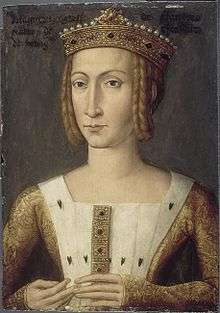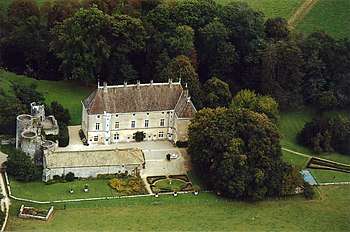Margaret III, Countess of Flanders
Margaret III (13 April 1350 – 16/21 March 1405) was the last countess of Flanders of the House of Dampierre, as well as countess of Artois and Burgundy (as Margaret II).
Margaret III | |
|---|---|
| Countess of Flanders | |
 Margaret of Dampierre, Countess of Flanders | |
| Born | 13 April 1350 Male Castle, West Flanders, Belgium |
| Died | 16 March 1405 (aged 54) Arras, Artois, France. |
| Noble family | Dampierre |
| Spouse(s) | |
Issue
| |
| Father | Louis II, Count of Flanders |
| Mother | Margaret of Brabant |
| Religion | Roman Catholicism |
Biography
Margaret was the only surviving child and heir of Count Louis II of Flanders (1346–1384) and Margaret of Brabant.[1] In 1355,[2] Margaret of Flanders married Philip of Rouvres,[3] grandson and heir of Odo IV, Duke of Burgundy. Philip was Count of Burgundy and Artois (1347–1361), Duke of Burgundy (1350–1361), and became Count of Auvergne and Boulogne (1360–1361).
Following Philip's death from a riding accident in 1361,[4] Margaret was widowed and had no issue by him. King John II of France then claimed the Duchy of Burgundy for the kingdom of France.[4] In 1364, Philip the Bold, King John's youngest son, was granted the duchy,[5] and subsequently married Margaret.[6] Margaret's second marriage to Philip the Bold took place in 1369.[7]
When Margaret's father, the Count of Flanders, died in 1384, she and Philip inherited the counties of Artois, Burgundy, Flanders, Nevers, and Rethel.[8] Philip died in 1404, and Margaret died the following year. With her death, the House of Dampierre came to an end, and the County of Flanders lost its (relative) independence to Burgundy. It came under the rule of her son, John the Fearless, and later to the House of Habsburg.
Issue
Margaret and Philip had the following children:
- John I of Burgundy, Duke of Burgundy (1371–1419, murdered at Montereau), her eldest son and successor in Flanders, Artois, and Burgundy.
- Charles of Burgundy (1372–1373)
- Margaret of Burgundy (October 1374 – March 8, 1441, Le Quesnoy), married William II, Duke of Bavaria.
- Louis of Burgundy (1377–1378)
- Catherine of Burgundy (April 1378, Montbard – January 24, 1425, Gray, Haute-Saône), married Leopold IV, Duke of Austria.
- Bonne of Burgundy (1379–1399, Arras)
- Mary of Burgundy (September 1380, Dijon – October 2, 1422, Thonon-les-Bains), married Amadeus VIII, Duke of Savoy.
- Antoine of Burgundy, Duke of Brabant (August, 1384 – October 25, 1415, at the Battle of Agincourt.)
- Philip II, Count of Nevers and Rethel (1389–1415, at the Battle of Agincourt.), as "Philip II".
Legacy
The main line of the House of Dampierre ended with Margaret III. The Dampierres, originally only counts of Flanders, had through a clever marriage policy managed to inherit the counties of Nevers (1280) and Rethel (1328). Through her grandmother, a daughter of King Philip V of France, the counties of Artois and Burgundy (the "Franche Comté") were added to this (1382). These lands were to provide the core of the dominions of the House of Valois-Burgundy, which were, together with the Duchy of Burgundy, to provide them with a power base to challenge the rule of their cousins, the Valois kings of France in the 15th century.
Her eldest son, John the Fearless, succeeded her husband in 1404 as Duke of Burgundy and her as Count of Burgundy, Count of Artois, and Count of Flanders. In 1406 her younger son Anthony inherited Brabant and Limburg. Nevers and Rethel were at first, in her lifetime, given to her eldest sons John (Nevers) and Anthony (Rethel), but after John's accession to the duchy, Nevers went to her youngest son Philip. Rethel was given to Philip in 1402 when it became clear that Anthony would inherit Brabant.
Residences
In Burgundy, the Château de Germolles, offered to Margaret of Flanders by Philip the Bold in 1381, was transformed by the Duchess of Burgundy into a sumptuous country estate. It was a large rectangular building, surrounded by a moat, that enclosed a courtyard. The south and east wings contained the living apartments, while the west wing held the reception rooms. Margaret, being energetic and a country lover, decided to develop at the estate some rustic activities that would create a pleasant environment around this favourite residence of hers, as well as developing local agriculture and providing some income for the maintenance of the domain. Thus, she planted a large rose garden, and the petals were sent to Flanders to be used to make rose water. Largely preserved, the Château is today one of the best examples of the princely residences in France at the end of the Middle Ages.
Ancestry
| Ancestors of Margaret III, Countess of Flanders | ||||||||||||||||||||||||||||||||||||||||||||||||||||||||||||||||||||||||||||||||||||||||||||||||||||||||||||||||||||||||||||||||||||||||||||||||||||||||||||||||||||||||||||||||||||||||||||||||||||||||||||||||||||||||||||||||||||||||||||||||||||||||||||||||||||||||||||||||||||||||||||||||||||||||||||||||||||||||||||||||||||||||||||||||||||||||||||||||||||||||||||||||||||||||||||||||||||||||||||||||||||||||||||||||||||||||||||||||||||||||||||||||||||||||||||||||||||||||||||||||||||||||||||||||||||||||||||||||||||||||||||||||||||||||||||||||||||||||||||||||||||||||||||||||||||||||||||||||
|---|---|---|---|---|---|---|---|---|---|---|---|---|---|---|---|---|---|---|---|---|---|---|---|---|---|---|---|---|---|---|---|---|---|---|---|---|---|---|---|---|---|---|---|---|---|---|---|---|---|---|---|---|---|---|---|---|---|---|---|---|---|---|---|---|---|---|---|---|---|---|---|---|---|---|---|---|---|---|---|---|---|---|---|---|---|---|---|---|---|---|---|---|---|---|---|---|---|---|---|---|---|---|---|---|---|---|---|---|---|---|---|---|---|---|---|---|---|---|---|---|---|---|---|---|---|---|---|---|---|---|---|---|---|---|---|---|---|---|---|---|---|---|---|---|---|---|---|---|---|---|---|---|---|---|---|---|---|---|---|---|---|---|---|---|---|---|---|---|---|---|---|---|---|---|---|---|---|---|---|---|---|---|---|---|---|---|---|---|---|---|---|---|---|---|---|---|---|---|---|---|---|---|---|---|---|---|---|---|---|---|---|---|---|---|---|---|---|---|---|---|---|---|---|---|---|---|---|---|---|---|---|---|---|---|---|---|---|---|---|---|---|---|---|---|---|---|---|---|---|---|---|---|---|---|---|---|---|---|---|---|---|---|---|---|---|---|---|---|---|---|---|---|---|---|---|---|---|---|---|---|---|---|---|---|---|---|---|---|---|---|---|---|---|---|---|---|---|---|---|---|---|---|---|---|---|---|---|---|---|---|---|---|---|---|---|---|---|---|---|---|---|---|---|---|---|---|---|---|---|---|---|---|---|---|---|---|---|---|---|---|---|---|---|---|---|---|---|---|---|---|---|---|---|---|---|---|---|---|---|---|---|---|---|---|---|---|---|---|---|---|---|---|---|---|---|---|---|---|---|---|---|---|---|---|---|---|---|---|---|---|---|---|---|---|---|---|---|---|---|---|---|---|---|---|---|---|---|---|---|---|---|---|---|---|---|---|---|---|---|---|---|---|---|---|---|---|---|---|---|---|---|---|---|---|---|---|---|---|---|---|---|---|---|---|---|---|---|---|---|---|---|---|---|---|---|---|---|---|---|---|---|---|---|---|---|---|---|---|---|---|---|---|---|---|---|---|---|---|---|---|---|---|---|---|---|---|---|---|---|---|---|---|---|---|---|---|---|---|---|---|---|---|---|---|---|---|---|---|---|---|---|---|---|---|---|---|---|---|---|---|---|---|---|---|---|---|---|---|---|---|---|---|---|---|---|---|---|---|---|---|---|---|---|---|---|---|---|---|---|---|---|---|---|---|---|---|---|---|---|---|---|---|---|---|---|---|---|---|---|---|---|---|---|---|---|---|---|---|---|---|---|---|---|---|---|---|---|---|---|---|---|---|
| ||||||||||||||||||||||||||||||||||||||||||||||||||||||||||||||||||||||||||||||||||||||||||||||||||||||||||||||||||||||||||||||||||||||||||||||||||||||||||||||||||||||||||||||||||||||||||||||||||||||||||||||||||||||||||||||||||||||||||||||||||||||||||||||||||||||||||||||||||||||||||||||||||||||||||||||||||||||||||||||||||||||||||||||||||||||||||||||||||||||||||||||||||||||||||||||||||||||||||||||||||||||||||||||||||||||||||||||||||||||||||||||||||||||||||||||||||||||||||||||||||||||||||||||||||||||||||||||||||||||||||||||||||||||||||||||||||||||||||||||||||||||||||||||||||||||||||||||||
References
- Sergio Boffa, Warfare in Medieval Brabant, 1356-1406, (Boydell & Brewer, 2004), xvii.
- Wim Blockmans and Walter Prevenier, The Promised Lands: The Low Countries Under Burgundian Rule, 1369-1530, transl. Elizabeth Fackelman, ed. Edward Peters, (University of Pennsylvania Press, 1999), 13.
- David M Nicholas, Medieval Flanders, (Routledge, 1992), 225-226, 442.
- W. Mark Ormrod, Edward III, (Yale University Press, 2011), 417
- Richard Vaughan, Philip the Bold: The Formation of the Burgundian State, Vol. 1, (The Boydell Press, 2005), 152
- Mapping Family Lines: A Late Fifteenth Century Example of Genealogical Display, Charlotte Bauer-Smith, Reputation and Representation in Fifteenth Century Europe, ed. Douglas L. Biggs, Sharon D. Michalove, Albert Compton Reeves, (Brill, 2004), 130.
- Wim Blockmans, Walter Prevenier, The Promised Lands: The Low Countries Under Burgundian Rule, 1369-1530, ed. Edward Peters, transl. Elizabeth Fackelman, (University of Pennsylvania Press, 1988), 1.
- Duchy of Burgundy, Cathal J. Nolan, The Age of Wars of Religion, 1000-1650: An Encyclopedia of Global Warfare and Civilization, Vol. 1, (Greenwood Publishing, 2006), 100.
Margaret III, Countess of Flanders Born: 13 April 1350 Died: 21 March 1405 | ||
| Regnal titles | ||
|---|---|---|
| Preceded by Louis of Mâle |
Countess of Flanders, Artois and Nevers Countess Palatine of Burgundy 1384–1405 |
Succeeded by John the Fearless |
| Countess of Rethel 1384–1402 |
Succeeded by Anthony | |
| French nobility | ||
| Preceded by Joan III of Burgundy |
Duchess consort of Burgundy 1357–1404 |
Succeeded by Margaret of Bavaria |
| Wikimedia Commons has media related to Margaret III, Countess of Flanders. |
